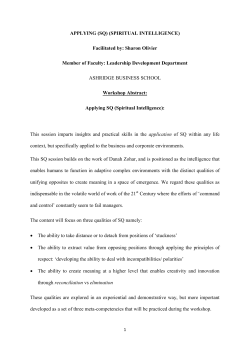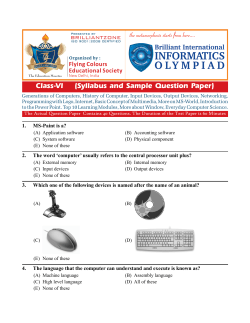
Fostering sharing with trust
Fostering sharing with trust Sonia Sousa Universidade Aberta Lisboa Portugal sonia.sousa@tlu.ee David Lamas Tallinn University Narva road, 25 Estonia david.lamas@tlu.ee Abstract As sharing heavily relies on trust, in this position paper we advocate for the use of a socio-technical model of trust to inform the design of sharing services. We start by presenting the model and them move one to establishing the relation between sharing and trust. We then deconstruct a sharing service proposal illustrating potential trust breakdowns. Finally, taking it as example, we illustrate how the socio-technical model of trust could have been used to inform the (re)design of the selected service. Author Keywords Human-computer trust; Socio-technical model of trust; Sustainability; Designing for Sharing ACM Classification Keywords H.5.3. [Group and Organization Interfaces]: Design, Reliability, Human Factors. Paste the appropriate copyright statement here. ACM now supports three different copyright statements: • ACM copyright: ACM holds the copyright on the work. This is the historical approach. • License: The author(s) retain copyright, but ACM receives an exclusive publication license. • Open Access: The author(s) wish to pay for the work to be open access. The additional fee must be paid to ACM. This text field is large enough to hold the appropriate release statement assuming it is single spaced. Every submission will be assigned their own unique DOI string to be included here. The socio-technical model of trust The proposed model, which we advocate to be use as a design tool for informing the design of sharing services, depicts trust as a construct informed by 7 (seven) individual qualities. The model determines the extent to which one relates with one’s social and technical environment [35, 36]. This model, see figure 1, is based on the combination of the unification of Davis’s and Venkatesh’s Technology Acceptance Models [9, 40], along with a extensive literature review on trust, complemented with participatory design sessions. The resulting model (after validation) takes into consideration certain observable qualities of trust that help to determine user’s intention of trust (Motivation and Willingness); incentive user’s usage behaviour (Competency and Predictability); and supports and moderates the relationships (Benevolence, Reciprocity and Honesty). Motivation Expectations Commitments Willingness Competency Rational perception Trust Predisposition Engagement Predictability Reciprocity Benovelence Emotional perception Relationships Honesty Qualities Beliefs Intentions Attitudes Fig.1. A model of Human-computer Trust [10, 9] The individual qualities of trust are: Motivation, that represents the degree to which an individual believe (even under conditions of vulnerability and dependence) h/she has the ability to perform specific beneficial action when using a computer. Willingness, reflects positive or negative feeling about performing a given action while considering the risk and incentives. Competency, reflects the degree of ease of use, when associated with the use of the system. Predictability, represents user’s confidence that the system will help him to perform a desired action in accordance with what is expected. Benevolence: reflects user’s perception that most people share similar social behaviours and sharing values. Reciprocity, represents the degree to which an individual sees oneself as part of a group. Honesty, reflects a insurance quality when facing apprehension, or even fear with the possibility of being deceived. The relation between sharing and trust Sharing is a social process that occurs between two or more persons that enjoy the benefit (or cost) of sharing a value, a good, time or skills [5]. Sharing differs from a economical transaction process as it not avoids feelings of commitment, instead it success lies in promoting it. This sharing economy or sometimes also referred to as collaborative economy arises from build new community notions of ownership and relationship. Those usually represent a network and reflect a variety of sharing forms like creation, production, distribution, trade and consumption of goods and services. This model of collaborative consumption enables participants to share and access to products or services, rather than having individual ownership. With it emerged a new market service that use new language of sharing, collaboration and peer-to-peer exchange for positioning sharing and collaboration and bridges the capacity to act in those new collaborative economies. Social capital is one addressed concept, that can be roughly translated as the ability to ”facilitate of actions” in society. Social capital emerges with people, when forming their social connections and networks. It is based on principles of trust, mutual reciprocity and norms of action [4, 13, 3]. Take for instance services like VGI Crowdsourcing geodata, it success lie on peer-to-peer volunteer contributions, and it increases through the system ability to incentive user’s contribution. Thus concepts like willingness, trust, credibility need to be addressed [1]. Or carpooling services where a study reports trust as the main problem behind it becoming too popular [2, 7]. Or even a study reporting significant relations between user’s trust and their attitudes towards sharing in open spaces in education settings [8, 6]. Indicating that in spite of, the majority of participants showed positive attitudes towards sharing and participate in open spaces, they also showed some trust concerns. For instance the most appreciated trust qualities to share or relate online are: honesty, the need/will to share, affinity and respect [8, 6, 12]. Above examples, besides establish a direct link between sharing and trust also, indicate the need for providing new models and visions where trust plays an important role in encouraging sharing interactions. Thus our argument, for the use of a socio-technical model of trust to inform the design of sharing services. Contributing that way for promoting successful sustainable and self-regulated sharing practices. Case study on sustainable sharing services We take as case study a sharing service called ”BiB”, this service was designed by HCI master level students for a sustainability course taught at Tallinn University, Estonia. The mobile tool main aim is to facilitate sustainable sharing practices and promoting community synergy in the society. To examine the service we used a trust-enabling design analytical tool derived from the model [11]. The main aim of the tool was to assess and inform to what extent the proposed tool features can explain describe trust-enabling interactions. As result of that analysis, we found that the proposed service presented very few design features to encourage meaningful trust-enabling interactions. For instance, it design proposed few incentives for leverage user’s will to consider the risk of using ”BiB” to exchange gadgets. In their proposal we also lack to see community enable features that encourage the trust value in sharing. What lead us to argue that in spite of in today’s collaborative economy we can see successful services that encourage interactions through trust, like neighborgoods, justshareit or airbnb. Those trust values, usually, are fostered intuitively and are not intentionally designed based on trust design frameworks. We propose to (re)design ”BiB” service by, for example, providing clear motivation hints on why to choose the tool and what user’s gain by using it. Also, it should enable incentive to trial and service exploration to trigger the willingness to trust. Regarding competency qualities, this is somehow shown through ”BiB” aesthetics and easy of use. But it can be improve if designer provide for example information/examples on usage practices, or sharing guidelines. Again, ”BiB” coherent design can be improved and ensure more predictability if complemented with user support sharing mechanisms like support forums and help guidelines. No benevolence design related qualities were found herein, they mention although wishing for a ”forgiveness” feature. We advise them, to provide as well caring, kindness/goodwill mechanisms through emotion ”buttons”. Regarding reciprocity, they propose to provide feedback through recommender system, what in our opinion is not enough. Maybe, they could enable people to testify on others or on the tool behalf. They should create as well small support group communities with similar interests and enabling friend (or friend of a friend) recommendations. Honesty hints are missing, they created a feature called ”circle of trust” but only for listing contacts. They should also add to that feature user’s cues on what the service does to prevent the possibility for deceiving. We suggest to complement this feature by define clear rules and responsibility mechanisms that ensure expel to those who not follow the rules, and by creating warning and advices lists. They should provide as well tool usage general statistics. Closing remarks In this position paper we express our arguments on the need for the use of a socio-technical model of trust to inform the design of sharing services, otherwise, those services instead of become a services which facilitate sharing they can promote more alienation than connection. [8] References [1] Coleman, D. J. Volunteered geographic information in spatial data infrastructure: an early look at opportunities and constraints. In GSDI 12 World Conference (2010). [2] Correia, G., and Viegas, J. M. Carpooling and carpool clubs: Clarifying concepts and assessing value enhancement possibilities through a stated preference web survey in lisbon, portugal. Transportation Research Part A: Policy and Practice 45, 2 (2011), 81–90. [3] Fukuyama, F., Ed. Trust: The social virtues and the creation of prosperity. Free Press, New York, 1995. [4] Kawachi, I., and Berkman, L. Social cohesion, social capital, and health. Social epidemiology (2000), 174–190. [5] Light, A., and Miskelly, C. Design for sharing. Research report, Northumbria University, EPSRC Digital Economy Sustainable Society Network+), 2014. [6] Lorenz, B., Sousa, S., and Tomberg, V. Privacy awareness of students and its impact on online learning participation - a case study. In Open and Social Technologies for Networked Learning: IFIP WG 3.4 International Conference, OST 2012, Springer Verlag (2013), 189 – 192. [7] Massaro, D. W., Chaney, B., Bigler, S., Lancaster, [9] [10] [11] [12] [13] J., Iyer, S., Gawade, M., Eccleston, M., Gurrola, E., and Lopez, A. Carpoolnow-just-in-time carpooling without elaborate preplanning. In WEBIST (2009), 219–224. Sousa, S., Laanpere, M., Lamas, D., and Tomberg, V. Interrelation between trust and sharing attitudes in distributed personal learning environments: The case study of lepress ple . In Advances in Web-based Learning, Lecture Notes in Computer Science, H. Leung, E. Popescu, Y. Cao, R. Lau, and W. Nejdl, Eds., Springer Verlag (2011), 72–81. Sousa, S., Lamas, D., and Dias, P. The interrelation between communities, trust and their online social patterns. In SCA2011 - International conference on Social Computing and its Applications, F. Xia, Z. Chen, G. Pan, L. T. Yang, and J. Ma, Eds., IEEE Computer Society (2011), 980–986. Sousa, S., Lamas, D., and Dias, P. A model of human-computer trust: A key contribution for leveraging trustful interactions. In CISTI’2014 - 9 Conferencia Ibrica de Sistemas y Tecnologas de Informacin, IEEE Computer Society (2014). Sousa, S., Lamas, D., Shmorgun, I., and Arakelyan, A. A design space for trust enabling interaction design. In Proceedings of the International Conference on Multimedia, Interaction, Design and Innovation MIDI 2014, ACM (2014). Sousa, S., Lamas, D., and Toming, K. Trust for supporting learning creativity in online learning communities. In New Horizons in Web Based Learning. Springer, 2014, 337–346. Tsai, W., and Ghoshal, S. Social capital and value creation: The role of intrafirm networks. Academy of management Journal 41, 4 (1998), 464–476.
© Copyright 2025









